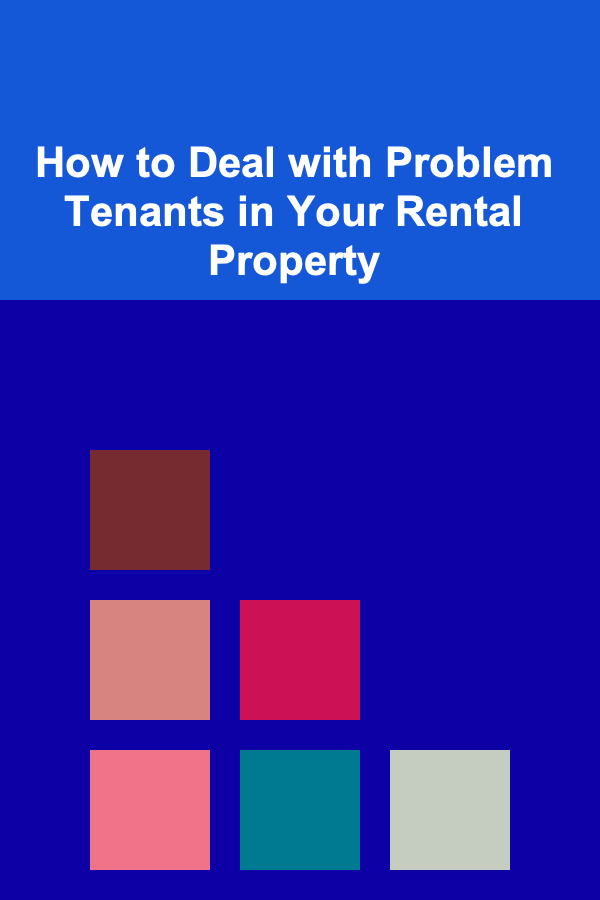
How to Stage Your Rental Property for Faster Leasing
ebook include PDF & Audio bundle (Micro Guide)
$12.99$8.99
Limited Time Offer! Order within the next:

Staging a rental property is one of the most effective ways to attract tenants quickly. Just like selling a home, the goal of staging is to present the property in its best light, enabling prospective tenants to envision themselves living there. By staging a rental property, you not only increase its appeal but also can command higher rents and reduce the time it sits vacant on the market.
However, staging a rental property requires a different approach compared to staging a home for sale. While homebuyers are looking for a personal connection and long-term investment, tenants are searching for functional, well-maintained spaces that meet their immediate needs. This article will delve into the strategies and best practices for staging your rental property to make it more appealing to potential tenants and accelerate the leasing process.
Clean and Declutter
Before you start worrying about decor, the first and most important step in staging your rental property is ensuring that it's clean and free from clutter. A clean, well-organized space is essential in making a positive first impression.
A. Thorough Cleaning
Start by giving the property a deep clean. This includes not only the floors, walls, and windows but also less obvious areas like baseboards, light fixtures, and appliances. If possible, hire professional cleaners to do the job, as they will have the tools and expertise to ensure every corner is spotless.
- Floors and Carpets: Steam clean carpets, wash floors, and polish hardwood or tile. Make sure any stains are removed.
- Windows: Clean windows inside and out. Sparkling windows let in more light and provide an unobstructed view.
- Kitchen and Bathrooms: These are some of the most scrutinized areas of a rental property, so ensure that counters, sinks, and appliances are clean and functioning. Clean grout, fix leaky faucets, and remove any mold or mildew.
B. Decluttering the Space
Decluttering is crucial in allowing potential tenants to see the full potential of the space. Remove personal items, excess furniture, and any items that may make the space feel smaller or cramped.
- Furniture: If the property is unfurnished, make sure it is free of any excess furniture or bulky items. If it's furnished, remove any personal items that might distract prospective tenants.
- Personal Items: Clear out any personal items such as family photos, books, or clothing. These items can make it difficult for tenants to imagine themselves in the space.
- Storage Areas: Clean and organize closets, cabinets, and other storage areas. Make them look spacious by removing unnecessary items and ensuring that each storage area is functional.
C. Deodorize the Property
Smells are one of the most powerful influencers on a person's perception of a space. Ensure that the property smells fresh and inviting.
- Air Fresheners: Avoid overpowering scents, as they can be off-putting. Instead, opt for neutral, fresh-smelling air fresheners or natural options like essential oils.
- Ventilation: Make sure the property is well-ventilated, as stagnant air can quickly turn foul. Open windows when possible and ensure that the HVAC system is working properly.
Highlight Key Features of the Property
When staging a rental property, the goal is to make its best features stand out. Whether it's a spacious living area, a modern kitchen, or a beautiful view, these are the elements that will resonate most with potential tenants.
A. Focus on Functionality
Tenants are primarily concerned with functionality. They need to see that the space will work well for their lifestyle. Consider highlighting the functionality of rooms like the kitchen and bathroom by ensuring that appliances are in good working condition, and fixtures are modern and appealing.
- Living Spaces: Ensure that the living areas are spacious, well-lit, and free from unnecessary furniture or distractions.
- Kitchen: The kitchen should be a focal point of staging. Make sure counters are clear, and that appliances are in good condition. A well-staged kitchen will appeal to tenants who cook frequently or those who are looking for ample storage space.
- Bathrooms: Staging the bathroom is all about creating a clean, fresh, and spa-like atmosphere. Ensure that mirrors, faucets, and lighting are in good condition, and remove any mold or soap scum. Fresh towels, a new shower curtain, or a new rug can elevate the space.
B. Show Off Natural Light
Natural light makes spaces feel open, airy, and inviting. Open all curtains or blinds before showing the property to maximize the amount of light that enters each room. Clean windows and ensure that nothing obstructs the flow of natural light, such as heavy furniture or dark curtains.
If your property lacks natural light, consider adding lighting fixtures like lamps or light-colored curtains to brighten the space. Light, neutral-colored walls also reflect more light and make spaces feel larger.
C. Create an Inviting Entrance
The entrance to your rental property is the first thing prospective tenants will see, so it's crucial to make a positive first impression.
- Front Door: Ensure that the front door is in good condition, and consider repainting it or installing new hardware if it looks worn.
- Outdoor Space: If you have an outdoor area like a porch, balcony, or backyard, make sure it's clean and inviting. Simple touches like potted plants or new outdoor furniture can make a significant difference.
- Entryway: The entryway should be tidy and functional. Consider adding a small table or a coat rack to make it feel more welcoming.
Use Neutral and Inviting Decor
The decor you choose for staging should be simple, neutral, and inviting. You want prospective tenants to be able to visualize their own belongings in the space, and overly personalized or bold decor choices can make that difficult.
A. Stick to Neutral Colors
Choose neutral colors for walls, furniture, and decor to create a versatile space that will appeal to the broadest range of potential tenants. Neutral tones such as whites, light grays, beige, and taupe can make a space feel larger and brighter.
- Walls: If your rental property has brightly colored walls, consider repainting them in a neutral shade to make the space feel more universally appealing.
- Furniture: If the property is furnished, use neutral-colored furniture that will appeal to a wide variety of tastes. Avoid bold patterns or bright colors that might not suit everyone.
B. Add Simple, Modern Furniture
If you are providing furniture for your rental property, keep it simple, modern, and functional. The furniture should suit the space and give the impression of a move-in-ready home.
- Living Room: A neutral-colored sofa, coffee table, and side tables are sufficient to make the living room feel inviting.
- Bedroom: A well-made bed with fresh linens can be the focal point of a bedroom. Consider adding a simple dresser or bedside tables for functionality.
- Dining Area: A small, simple dining table or breakfast bar can make the dining area feel cozy and practical.
C. Keep Decor Minimal
When it comes to decorating a rental property, less is more. Avoid overcrowding the space with too much decor. Instead, opt for a few key pieces such as:
- Throw pillows: A couple of neutral-colored throw pillows on the sofa can make a living room feel cozy.
- Artwork: Hang a few pieces of neutral artwork or framed prints to create a sense of style without being too bold or personalized.
- Plants: Adding a few potted plants or greenery can make a space feel fresher and more inviting without taking up too much space.
Make Necessary Repairs and Upgrades
Before staging your rental property, make sure that all necessary repairs and upgrades have been made. The goal is to present the property as a well-maintained, functional space that tenants can move into immediately.
A. Repair Leaks, Cracks, and Broken Fixtures
Fix any plumbing issues such as leaks or dripping faucets. Repair any cracks in the walls, ceilings, or flooring, as these issues can make the property feel neglected.
- Fix Leaky Faucets: Dripping faucets can be irritating to tenants and signal that the property isn't well-maintained.
- Repair Cracks: Cracked walls, ceilings, or tiles can make the property seem rundown. Patch up any cracks and repaint if necessary.
B. Upgrade Outdated Fixtures
Updating outdated or broken fixtures is one of the most cost-effective ways to increase the appeal of your rental property. Replace old, worn-out faucets, light fixtures, and cabinet handles with modern, sleek options.
- Lighting Fixtures: Upgrade outdated lighting fixtures with modern, energy-efficient options.
- Cabinet Hardware: If the kitchen or bathroom cabinets are in good shape but look old, consider replacing cabinet knobs and handles for a quick and inexpensive upgrade.
C. Consider Small Renovations
If the property has significant wear and tear or outdated features, consider small renovations that can enhance its appeal. For example, installing new flooring, updating the countertops, or replacing old appliances can significantly increase the value of your rental property.
Photography and Marketing
Once your rental property is staged, it's time to capture its best features through professional photography. High-quality photos will make a significant difference in how quickly your property rents.
A. Hire a Professional Photographer
Hiring a professional photographer who specializes in real estate can help you showcase your property in the best light. They understand how to highlight the space and use lighting to enhance its features. Good photos will make your rental property stand out on listing sites and attract more potential tenants.
B. Use Virtual Staging If Necessary
If your rental property is empty and you don't want to invest in physical staging, consider using virtual staging. Virtual staging involves digitally placing furniture and decor into photographs of the empty space. While it may not have the same impact as physical staging, virtual staging can still help tenants visualize the space and its potential.
Conclusion
Staging a rental property is an investment that can pay off by attracting more tenants and reducing vacancy time. By focusing on cleanliness, functionality, and neutral decor, and making necessary repairs and upgrades, you create a welcoming environment that will appeal to a broad audience. Effective staging will highlight the property's best features and make it easy for prospective tenants to imagine themselves living there.
Ultimately, the goal of staging is to make the property feel like a place where tenants can immediately move in and start living. When done correctly, it can shorten the time it takes to lease the property, maximize your rental income, and enhance the overall success of your rental business.
Reading More From Our Other Websites
- [Organization Tip 101] How to Set Up Alerts for Suspicious Activity Around Your Home
- [Organization Tip 101] How to Use a Label Maker for Streamlined Organization
- [Whitewater Rafting Tip 101] How to Plan, Pack, and Prepare for a Weekend Rafting Getaway
- [Personal Care Tips 101] How to Tell the Difference Between Acne Treatment Creams for Adults and Teens
- [Organization Tip 101] How to Design a Multi-Functional Garage Layout
- [Home Space Saving 101] How to Organize Your Kitchen for Maximum Efficiency in Limited Space
- [Home Cleaning 101] How to Clean and Sanitize Kids' Toys
- [Hiking with Kids Tip 101] From Kids to Grandparents: Respectful Trail Practices for All Ages
- [Home Pet Care 101] The Do's and Don'ts of Pet Grooming
- [Organization Tip 101] How to Refresh Your Family Room Organization for the New Year

How to Deal with Problem Tenants in Your Rental Property
Read More
How to Keep Your Pet's Paws Clean and Healthy Indoors
Read More
How to Refresh Your Home's Air Quality with Cleaning
Read More
How to Respond to a Home Security Breach Effectively
Read More
How to Develop a Workout Routine for Fat Loss
Read More
How to Create Printable Signs for Kids' Birthday Parties
Read MoreOther Products

How to Deal with Problem Tenants in Your Rental Property
Read More
How to Keep Your Pet's Paws Clean and Healthy Indoors
Read More
How to Refresh Your Home's Air Quality with Cleaning
Read More
How to Respond to a Home Security Breach Effectively
Read More
How to Develop a Workout Routine for Fat Loss
Read More